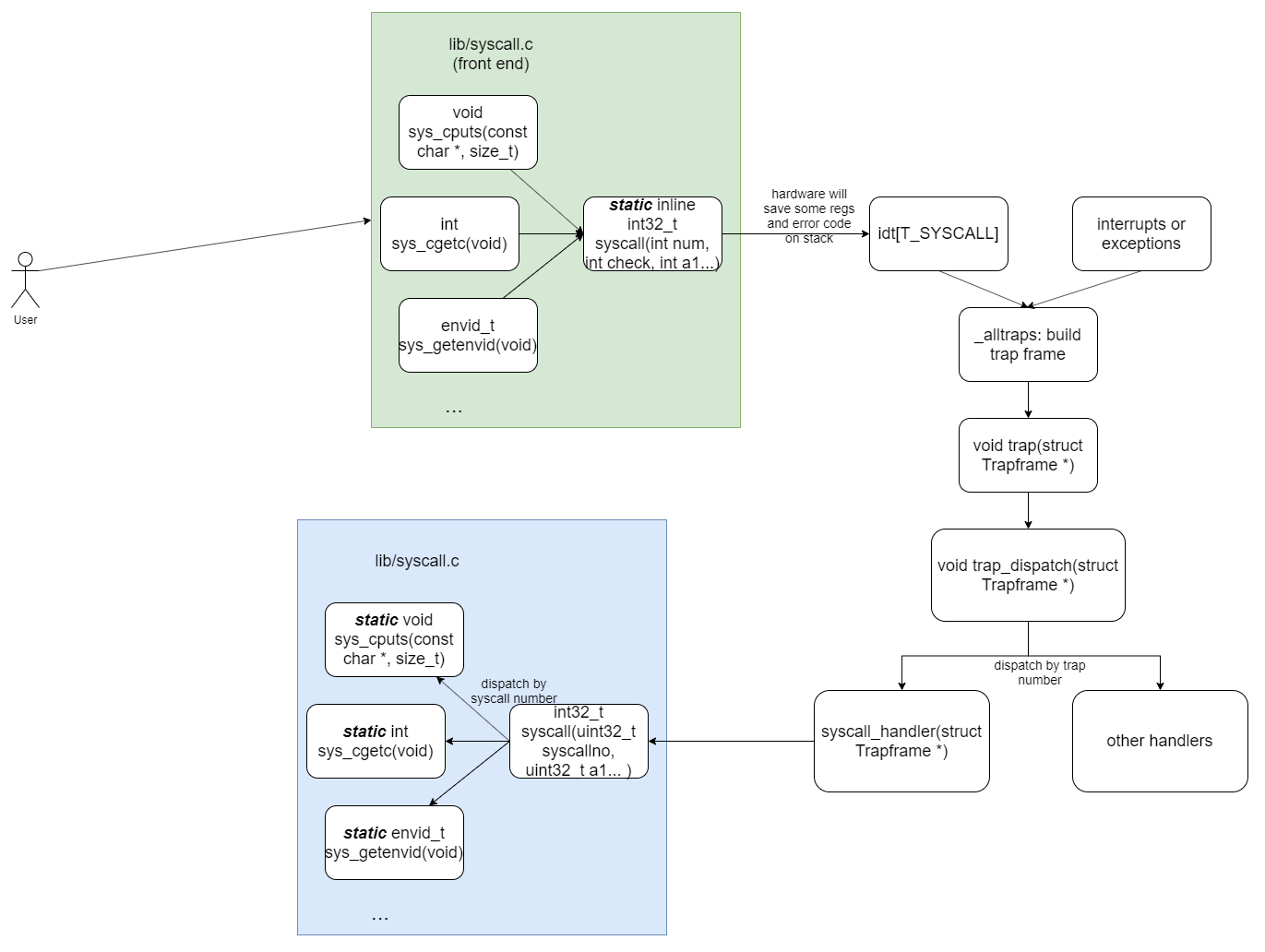lab 3 断断续续写了小久,终于糊完了。虽然没能完全独立地解决所有实现细节,但对 JOS 系统调用的实现有了点理解,在此做下记录。
Interrupt & Exception
后文当提到中断,它可能包括 Interrupt 和 Exception ,也可能单指 Interrupt ,视上下文而定。
JOS 的系统调用是利用类似中断的机制实现的,即:
- 保存当前进程的上下文,主要是各种寄存器
- 陷入内核,根据中断向量(一个小整数)来确定处理程序的入口
- 调用处理程序,获得结果
- 如果中断和异常能被正确处理,恢复进程上下文,程序继续执行
关于中断部分的介绍也可以跳过
lab 3 让我们阅读 Intel 中断部分的手册,相关术语在各种架构之间并没有很多的统一,下面会基于 Intel 资料简单介绍下中断。
一般说中断,我们会包括 Interrupt 和 Exception ,Interrupt 可分为:
- external (hardware generated) interrupt
- software generated interrupt ,通过
INT n指令触发
Exception 则一般是在程序执行过程中被触发,比如当执行指令时访问了一个地址发生缺页异常。还有一类称为软中断(software interrupt),即通过指令显示地触发,它包括了上面 Interrupt 的第二种分类。这两种分类标准分别出现于下面两个 6.828 提供的文档,有点自相矛盾但无伤大雅。
参考:
- [1]
- [2] 5.3 Sources of Interrupts
综上,一般异常是同步的,一般是程序(不自觉或自觉地)主动触发中断机制;而由硬件触发的中断是异步的,比如一个时间中断突然把一个程序的执行流打断。
中断向量表
上面提到异常和中断的处理是用的同一套机制,这其中有一个很重要的概念叫中断向量表(Interrupt Descriptor Table 简称 IDT),其实是一个数组。不同中断、异常都需要对应的处理程序(handler),IDT 的一项就对应着一个处理程序,由一个小整数标识。
IDT 有 256 项,0-31 被 Intel 保留,比如 0 是 divide by zero ;32-255 开放给用户自定义,通常用于处理外部的硬件中断。
[2] 5.2 EXCEPTION AND INTERRUPT VECTORS
Vectors in the range 32 to 255 are designated as user-defined interrupts and are not reserved by the Intel 64 and IA-32 architecture. These interrupts are generally assigned to external I/O devices to enable those devices to send interrupts to the processor through one of the external hardware interrupt mechanisms (see Section 5.3, “Sources of Interrupts”).
0-31 除去一些保留的以及 NMI ,大部分都是异常,可查看 [2] Table 5-1. Protected-Mode Exceptions and Interrupts 。
JOS 使用了 48(0x30) 作为系统调用的中断向量,使得我们可以像处理异常、中断一样处理系统调用。
系统调用流程
这一节我们从一个系统调用入手,来观察整个过程是如何发生的。
用户与内核的边界
这个系统调用是位于 lib/syscall.c 的 sys_cputs ,其定义为:
int
sys_cgetc(void)
{
return syscall(SYS_cgetc, 0, 0, 0, 0, 0, 0);
}
这里调的 syscall 是同文件下的一个 static function (只在当前文件下可见,所以用户无法直接调用,一种保护、隔离内核的手段):
static inline int32_t
syscall(int num, int check, uint32_t a1, uint32_t a2, uint32_t a3, uint32_t a4, uint32_t a5)
{
int32_t ret;
// Generic system call: pass system call number in AX,
// up to five parameters in DX, CX, BX, DI, SI.
// Interrupt kernel with T_SYSCALL.
//
// The "volatile" tells the assembler not to optimize
// this instruction away just because we don't use the
// return value.
//
// The last clause tells the assembler that this can
// potentially change the condition codes and arbitrary
// memory locations.
asm volatile("int %1\n"
: "=a" (ret)
: "i" (T_SYSCALL),
"a" (num),
"d" (a1),
"c" (a2),
"b" (a3),
"D" (a4),
"S" (a5)
: "cc", "memory");
if(check && ret > 0)
panic("syscall %d returned %d (> 0)", num, ret);
return ret;
}
这里使用了内联汇编,我们把 num 系统调用号放入了 %eax ,参数 1-5 放入了 %eds 等寄存器(见注释)。然后执行指令 int $T_SYSCALL ,接下来发生的事情就是中断机制那一套了,这里便是用户和内核之间的边界。最终我们会把系统调用的返回值放在变量 ret 中。
中断向量表初始化
这一节不感兴趣可以先行跳过
在 int $T_SYSCALL 之后,我们需要去 IDT 中寻找第 T_SYSCALL 即 48 个表项作为中断处理程序。在此前,我们可以稍微说下 JOS 的中断向量表是如何初始化的。
在 kern/trap.c trap_init.c 中,通过 SETGATE 宏为每个中断向量逐个设置处理程序。
SETGATE(idt[T_DIVIDE], 0, GD_KT, trap_handler_divide, 0);
SETGATE(idt[T_DEBUG], 0, GD_KT, trap_handler_debug, 0);
SETGATE(idt[T_NMI], 0, GD_KT, trap_handler_nmi, 0);
这里的 trap_hanlder_divide 就是一个处理程序,你也不会找到它的函数体,它是利用 TRAPHANDLER_NOEC(trap_handler_divide, 0) 宏定义的:
/* Use TRAPHANDLER_NOEC for traps where the CPU doesn't push an error code.
* It pushes a 0 in place of the error code, so the trap frame has the same
* format in either case.
*/
#define TRAPHANDLER_NOEC(name, num) \
.globl name; \
.type name, @function; \
.align 2; \
name: \
pushl $0; \
pushl $(num); \
jmp _alltraps
这里的 num 是 0 ,它是除零错误的中断向量。 push $0 是压了一个伪 error code ,因为对于一些异常 CPU 不会为我们压入 error code ,为了保持一致我们压了一个 0 。TRAPHANDLER_NOEC 的变体是 TRAPHANDLER (会压入 error code)。所有的中断处理程序都是用这两个宏(TRAPHANDLER_NOEC 和 TRAPHANDLER)定义的,它们都会 jump 到 _alltraps 这个统一入口点。这个入口点会建立 trap frame ,保存进程的上下文。
trap frame
定义
在处理包括系统在内的中断之前,我们需要保存当前进程的上下文,即进程的“状态”,主要是各种寄存器,这样在中断处理结束后我们可以让进程继续从当前上下文继续执行。
在 JOS 中,进程状态的定义是 struct Trapframe,可以注意到 trap frame 是由 hardware 和 kernel 共同构建的:
struct Trapframe {
struct PushRegs tf_regs; // all registers that pushed by `pusha` instruction
uint16_t tf_es;
uint16_t tf_padding1;
uint16_t tf_ds;
uint16_t tf_padding2;
uint32_t tf_trapno;
/* below here defined by x86 hardware */
uint32_t tf_err;
uintptr_t tf_eip;
uint16_t tf_cs;
uint16_t tf_padding3;
uint32_t tf_eflags;
/* below here only when crossing rings, such as from user to kernel */
uintptr_t tf_esp;
uint16_t tf_ss;
uint16_t tf_padding4;
} __attribute__((packed));
构建
在中断向量表初始化时我们提到 _alltraps 这个中断的统一入口点:
.global _alltraps
_alltraps:
# build trap frame
pushl %ds
pushl %es
pushal
# set up ds es
movw $GD_KD, %ax
movw %ax, %ds
movw %ax, %es
# call trap(tf)
pushl %esp
call trap
头三条指令建立 trap frame ,后面切换了段寄存器。pushl %esp 这个有点小 trick ,当前 %esp 指向栈顶,栈顶包含了各种寄存器。结合 C 的 calling convention ,其实是把 %esp 作为参数作为 trap(tf) 的参数进行了一个调用。
trap(tf) 调用了 trap_dispatch(tf) ,进行中断的分发:
static void
trap_dispatch(struct Trapframe *tf)
{
// Handle processor exceptions.
switch (tf->tf_trapno)
{
case T_PGFLT:
/* code */
page_fault_handler(tf);
return;
case T_BRKPT:
case T_DEBUG:
monitor(tf);
return;
case T_SYSCALL:
syscall_handler(tf);
return;
default:
break;
}
...
}
根据 trap frame 的 tf_trapno ,我们找到对应的处理程序。对于系统调用,就是我们的 syscall_handler 。
system call handler
注意到在用户与内核的边界这一节的内联汇编中,我们在执行 int $T_SYSCALL 之前还设置了寄存器,包括系统调用号和系统调用的参数,在用户态陷入内核前,我们将这些信息保存在进程的寄存器。于是在 _alltraps 的 pushal ,这些信息借由寄存器就被放在 trap frame 中了。
所以在系统调用的处理程序中,我们通过 tf 获取这些参数,然后执行一个 syscall(),并把返回值放回 trap frame 的 %eax 寄存器中。在进程恢复执行后,返回值就位于 %eax 中,相当于执行了一次函数调用。
void syscall_handler(struct Trapframe *tf)
{
int num = tf->tf_regs.reg_eax;
int a1 = tf->tf_regs.reg_edx;
int a2 = tf->tf_regs.reg_ecx;
int a3 = tf->tf_regs.reg_ebx;
int a4 = tf->tf_regs.reg_edi;
int a5 = tf->tf_regs.reg_esi;
int ret = syscall(num, a1, a2, a3, a4, a5);
// when resume user process, it can get return
// value directly by accessing %eax
tf->tf_regs.reg_eax = ret;
}
这里的 syscall 要和前面的区分开,它位于 kern/syscall.c 中:
// Dispatches to the correct kernel function, passing the arguments.
int32_t
syscall(uint32_t syscallno, uint32_t a1, uint32_t a2, uint32_t a3, uint32_t a4, uint32_t a5)
{
// Call the function corresponding to the 'syscallno' parameter.
// Return any appropriate return value.
switch (syscallno) {
case SYS_cputs:
sys_cputs((char*)a1, a2);
return 0;
case SYS_cgetc:
return sys_cgetc();
case SYS_getenvid:
return sys_getenvid();
case SYS_env_destroy:
return sys_env_destroy(a1);
default:
return -E_INVAL;
}
}
咦,这里的 sys_cputs() 不就是我们一开始说的那个系统调用吗?不是,这是 kern/syscall.c 下的一个 static function:
static int
sys_cgetc(void)
{
return cons_getc();
}
总结
最终,我们可以给出这么一个系统调用的流程图:

Reference
[1] https://pdos.csail.mit.edu/6.828/2018/readings/i386/c09.htm
[2] https://pdos.csail.mit.edu/6.828/2018/readings/ia32/IA32-3A.pdf
